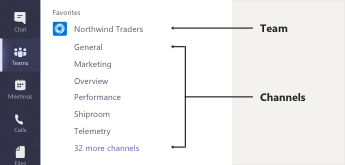If you're working from home, a small business, or if you want to roll out Teams starting with chat, teams & channels, and meetings, use our prescriptive Get started guidance, which is designed to get you up and running quickly. If you're a large organization with a hybrid or on-premises Skype for Business configuration, or if you want to roll out voice features (such as Office 365 calling plans or phone system), you can start with our Get started guidance, but you'll need the additional guidance below, under Deeper adoption guidance.
Adoption plans can be simple to complex, depending on your environment. For large-scale deployments, step through the guidance below to ensure your organization has a smooth transition to Teams.
https://docs.microsoft.com/en-us/MicrosoftTeams/adopt-microsoft-teams-landing-page
· Get started
·
Reduce & Improve Email with Microsoft Teams
Check your environment’s readiness for Teams
Teams and Channels?
A team is a group of people gathered to get something big done in your organization. Sometimes it’s your whole organization.
Teams are made up of channels, which are the conversations you have with your teammates. Each channel is dedicated to a specific topic, department, or project.

For this example, the Northwind Traders team has General, Marketing, Overview, and 35 more channels. All the conversations, meetings, files, and apps in the Marketing channel have to do with marketing, and everything in this channel is visible to everyone on the Northwind Traders team. Channels are where the work actually gets done—where text, audio, and video conversations open to the whole team happen, where files are shared, and where apps are added. While channel conversations are public, chats are just between you and someone else (or a group of people). Think of them like instant messages in Skype, Skype for Business or other messaging apps.
03/05/2024